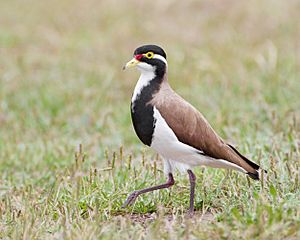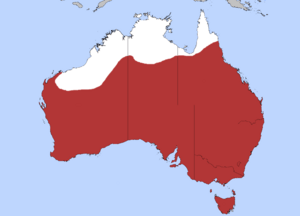Banded lapwing facts for kids
Quick facts for kids Banded lapwing |
|
|---|---|
 |
|
| Conservation status | |
| Scientific classification | |
| Genus: |
Vanellus
|
| Species: |
tricolor
|
 |
|
| Distribution of the banded lapwing | |
| Synonyms | |
|
Charadrius tricolor Vieillot, 1818 |
|
The banded lapwing (Vanellus tricolor) is a medium-sized bird that lives near shores. You can find them in groups, big or small, in open grassy areas, farms, and savannas. These birds are originally from Australia. In the past, people sometimes hunted them. There are about 25,000 to 1,000,000 banded lapwings in the world. People also call them the banded, black-breasted, brown flock, or plain plover.
Contents
What is a Banded Lapwing?
-
Adult on Rottnest Island
Bird Family
Banded lapwings belong to the bird family called Charadriidae. This family includes birds like plovers. There are 25 different types of lapwings alive today. Africa has the most kinds of lapwings. Australia has two native types: the masked lapwing and the banded lapwing. Scientists have found old fossils of Vanellus birds that are about 30 million years old.
How to Spot One
The banded lapwing is a medium-sized shorebird. It has short, dark purplish legs and a dull red part above its knee. These birds are usually 25 to 29 centimeters (about 10-11 inches) long. They weigh around 190 grams (about 6.7 ounces). They stand tall and walk slowly. If they get scared, they trot faster.
Their beak is pale yellow with a black tip. They have a small red wattle (a fleshy growth) near the base of their beak. This wattle and the spurs on their wings are bigger on males than on females.
Banded lapwings have a black cap on their head. Their throat and belly are white. They have white stripes near their eyes. A black band crosses their chest and goes up each side of their neck to their face. Their eyes are bright yellow. When they fly, their wings beat quickly, which is why they are called 'lapwings'.
Young lapwings are a bit smaller, from 22 to 25.5 centimeters long. They weigh between 124 and 133 grams. Young birds look a lot like adults. However, their head, neck, and chest might have dark brown spots. The feathers on their upper body are tan.
Where They Live
Banded lapwings are only found in Australia. They live across the mainland and in Tasmania. You won't often find them in northern Australia or in most coastal areas. They don't need to live near water. They can live far away from it.
These birds like open plains and areas with short grass. This includes heavily grazed fields, farms, and new cereal crops. They are most common inland. They avoid areas with thick Acacia bushes. They might live there if the bushes are more spread out due to too much grazing.
Clearing forests for farms in southern Australia has probably helped these birds. Outside of breeding season, banded lapwings gather in small groups. They move around a lot. Their movements depend on the weather and seasons. In Victoria, they are seen most often in spring and winter. This suggests they breed when there is more rain.
What They Eat
Banded lapwings are always looking for food. They eat during the day and at night. They prefer areas with very short grass. They eat seeds and insects. Their diet includes worms, ants, termites, beetles, cockroaches, grasshoppers, crickets, and caterpillars.
Raising a Family
When banded lapwings breed, they usually move inland, away from wetlands. They stay with one partner. They usually breed once a year. This happens across their normal living areas. The breeding season is from June to November. However, in dry inland areas, they might nest any month after it rains.
They usually make their nests in open areas. They stay far from trees or bushes. This way, the sitting bird can see everything around them. Nests are just a shallow dip in the ground. They are usually lined with plants. Sometimes, they use small stones, twigs, or animal droppings.
The eggs hatch in 26 to 28 days. Both parents take care of the young. The eggs and chicks are very well hidden. They blend in with their surroundings. A female usually lays three to four eggs. The eggs are light brown with brown and blackish-brown spots. They are about 42 mm by 32 mm and shaped like a pear.
During breeding season, they are very protective of their territory. They will attack any animal that comes too close to their nests. They use their wing spurs to fight. If there is danger, chicks will freeze and stay very still. Parents will try to distract intruders. They might pretend to be hurt to lure the intruder away. They also protest loudly and swoop at anyone who gets too close.
When alarmed, they make a loud 'kew-kew-kew' call. They also make a descending 'er-chill-char, er-chill char' sound. Young birds can fly when they are three to four weeks old. Sometimes nests fail because farm animals step on them. Nests can also be destroyed by vehicles or too many people disturbing them.
Keeping Them Safe
To help banded lapwings, we need to manage farm and grazing lands properly. These birds use many different open habitats and farmlands. Luckily, there are no big or immediate threats to their survival right now.
See also
 In Spanish: Avefría tricolor para niños
In Spanish: Avefría tricolor para niños





